Deflation Will Drive The Price Of Gold Lower
.
- What you don't know about deflation can hurt your investments.
- The proper definition of deflation explained.
- Deflation is why I have stuck with my calls for lower prices in gold, and been right about them, even though I sell gold and silver for a living.
- What deflation means for the future prices of the dollar and gold.
(click to enlarge)
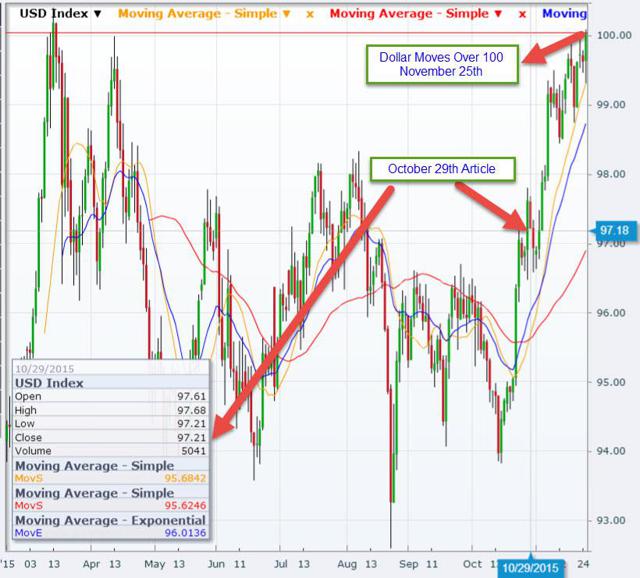
(click to enlarge)
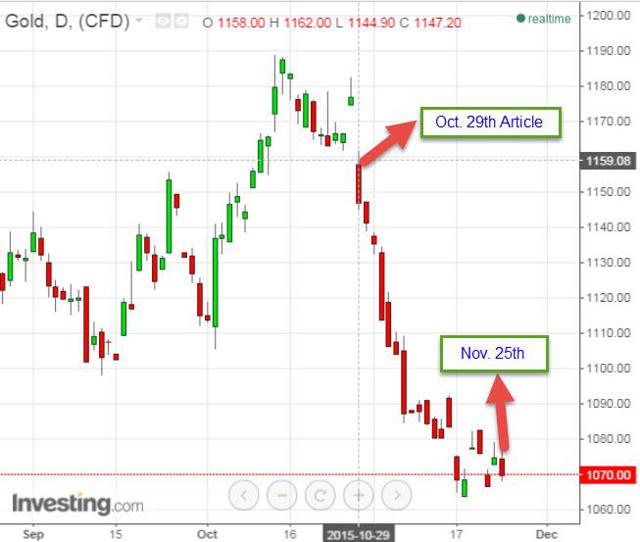
Ever since I wrote my first book Buy Gold and Silver Safely in 2010 I have been in the deflation camp. I spent a month straight researching Chapter 4 of that book where it explained in detail the potential of a deflationary credit contraction. At the time there was an ongoing debate among many on whether we were going to experience inflation or deflation. It is clear now we are in deflation yet investors still don't know what that means or how it could affect their investments.
Before getting into detail on what I see going on with deflation, we must first start with the proper definition of deflation.
The third type of deflation we will consider results from the tightening of credit which normally occurs in the crisis and recession stage that follows all credit expansion. Just as credit expansion increases the quantity of money in circulation, the massive repayment of loans and the loss of value on the assets side of banks' balance sheets, both caused by the crisis, trigger an inevitable, cumulative process of credit tightening which reduces the quantity of money in circulation and thus generates deflation. This third type of deflation arises when, as the crisis is emerging, not only does credit expansion stop increasing, but there is actually a credit squeeze and thus, deflation, or a drop in the money supply, or quantity of money in circulation.
Money, Bank Credit, and Economic Cycles, Jesús Huerta de Soto, 2006 PP. 445-448, 452-53If one doesn't include credit into the definition of deflation then they are missing the 100's of trillions of dollar worth of assets contracting that are keeping the Fed's QE non-effective and money velocity at a standstill. To see what I mean, I refer you once again to Exter's pyramid where you see what I call "quasi" or "illusions of wealth" trickling down to the perceived wealth that Treasuries and eventually gold will provide.
(click to enlarge)
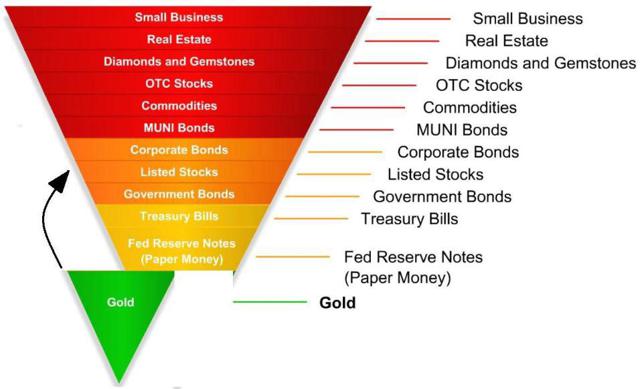
(click to enlarge)
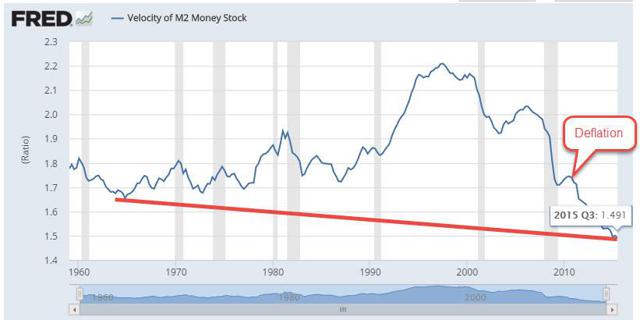
From the Fed:
Declining Velocity
The issue has to do with the velocity of money, which has never been constant, as can be seen in the figure above . If for some reason the money velocity declines rapidly during an expansionary monetary policy period, it can offset the increase in money supply and even lead to deflation instead of inflation. SourceNot only do we have an offset of the increase in money supply, as seen by the chart below, but also the bouts of QE we have had in unprecedented action by the Fed.
(click to enlarge)
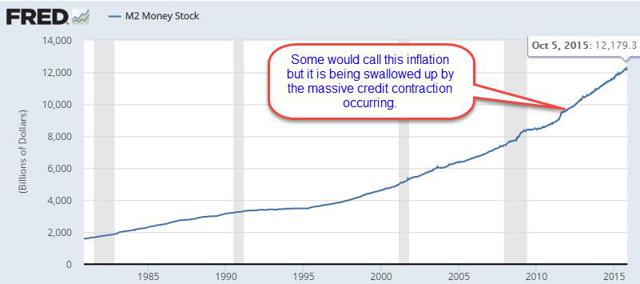
(click to enlarge)
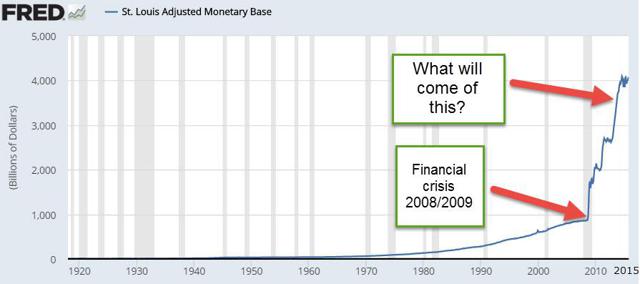
The Monetary base consists of credit from the bank that is converted to base money on demand (withdrawals, transfers, etc.). Bank reserves, also part of the monetary base, are supposed to be used for the bank credit system to function (loaning out this money to consumers and businesses), but it's just not happening. The banks keep this money on their books and are happy just receiving their interest payments from the Fed. If you owned a bank would you like to lock in a low interest loan for the next 10, 20, 30 years when we are at historic lows?
This is what most don't understand about what's occurring today and the frustrating part is, the Federal Reserve doesn't understand the failure of their own policy. The banks aren't lending but hoarding!
Bernanke wrote in a 2002 speech on deflation that he thinks the Fed can drop money from helicopters to stimulate demand anytime they want to. The problems the Fed faces however stem from a lower demand for credit. Boomers and others are choosing to pay down debt and save any money that comes their way, hence the contraction. The Fed may resort to negative interest rates to try and spark money velocity and stroke inflation higher but will it work? This is deflationary but when this changes, we'll finally see gold take off higher.
The Fed could of course lower the rate it pays banks to get the money off their books. In fact, it is the lowering of the Federal Funds rate that has got us out of most credit crisis we have had since the 80's U.S. banking crisis. The problem is, they don't have anywhere to go but negative now.
(click to enlarge)
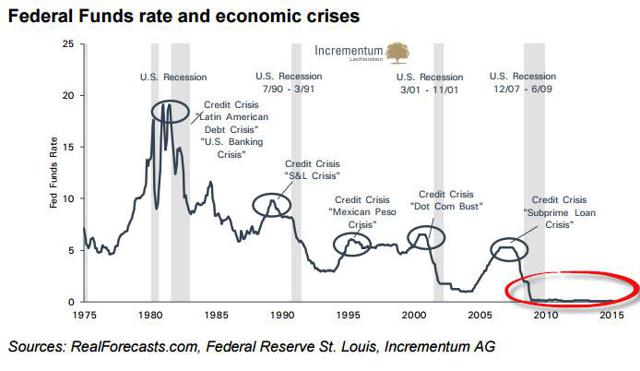
The most incredible aspect to the chart above is the fact that since the 1980's, the Fed has always been able to stimulate after a crisis and we experience the "boom" part of the cycle. But what has them perplexed since 2010 is this time it's not working.
The amount of credit debt according to Ned Davis Research, is over $58 trillion and dwarfing this M2 growth. I wrote about this credit contraction in a recent article April Call To Wait And Buy Gold Below $1,000 Still In Effect where I said; "One can't look at M2 alone, they must include credit into the equation."
The Fed has tried every trick in the book to get the economy and money velocity going to get to their 2% inflation goal and now they are going to raise rates? Believe me when I say, at some point they will get it but it would be a mistake to do it now.
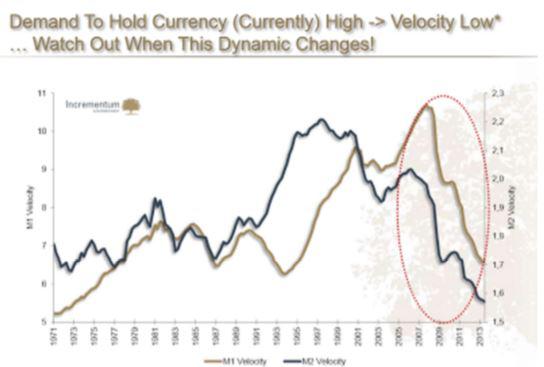
It is fear that will change this dynamic. But for now, we have to still reap the affects of monetary policy and the kicking of the QE can down the road a bit longer. The funny thing to me is the Fed and CNBC have been talking about raising rates for over a year now and they do so every meeting, knowing full well we wait with baited breath as market participants as to what they said. It's ridiculous in my opinion. I don't care what the Fed says or thinks. I follow market action and my indicators and trade accordingly.
The Fed is stuck where they are and if they do raise rates it will be a one and done credibility raise just to win over those that have been waiting for over a year for that rise in rates.
Unfortunately though, investing has been turned on its head as fundamentals no longer matter.
Economic data no longer matters. What is the Fed going to do is the new mantra for Wall St.
But when? How long can this game continue? The following graphic will give you a hint of what's to come.
(click to enlarge)
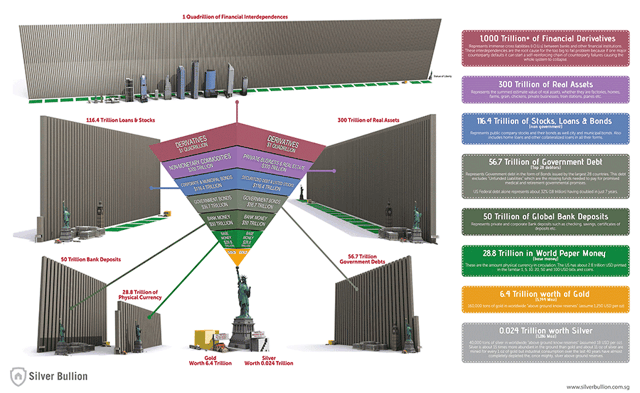
The graphic above is a new way to look at Exter's pyramid. When fear finally enters the picture, many of your investments may in some of the assets depicted in the graphic could be subject to losses as you'll see a tsunami of these illusions of wealth (title of my next book) flowing down to what is perceived safety, first in treasuries and dollars pushing the dollar higher, and ultimately into the physical metals where as you can see from the graphic, there really isn't much of it available.
One of the first gentlemen who taught me about gold was Richard Russell, who at 92 just passed away this last Saturday. He wrote his Dow Theory Letters to the very end of his life. His comment about the 3rd phase of a gold market he describes is where "gold will go to undreamed of heights." I am on the same page as Richard, after this fake economy is exposed for what it is, and not just because I sell metals for a living. I provide data to back up anything I write and so far it's allowed me to call the metals market as well as anyone who is considered an expert. I didn't waver the last few times when prices moved higher. I dealt with the criticism of those who thought gold had bottomed. I stuck with my analysis and still do.
Once we are under $1,000 an ounce in gold, which we are only about $70 away, my job in analyzing the markets will become more difficult. But I will leave you with this thought; if you bought gold today at $1,070 or caught the bottom just under $850 if it got that low, and now it is 5 years down the road and gold is $2500 an ounce or higher, does it matter where you bought?
For example, one buyer buys at $1,200 gold and another buys at $900. The one who bought at $1,200 paid 33% more for their gold, but at the $2,500 price for gold, assuming we get there, one investor made 108% and the other 177%.
Can you tell me one other investment that has the propensity to go higher in price faster than a basket of commodities, especially of the precious kind like gold and silver once we bottom out?
After finishing the investment chapter for my next book and spending time analyzing these markets, coupled with my almost 30 years in the financial services industry, I sure can't.
My advice is to buy the physical metal as low as cost to spot. This would be silver rounds and bars as well as gold bars if you want the cheapest. Some may want to buy the various ETFs out there which I call "trading vehicles" like (NYSEARCA:GLD) or (NYSEARCA:PHYS) for gold or (NYSEARCA:SLV) or (NYSEARCA:PSLV) for silver. These paper ETFs are not insured and not very liquid unless you are very wealthy but do have some low fees. You have to weigh the importance of controlling your own wealth you hold in your hands like you would a gun or leave that wealth in the hands of someone else to take care of your wealth for you. In times of real fear, which at some point I believe will come, you'll want to own the physical but the premiums to convert to it may be much higher than they are today.

0 comments:
Publicar un comentario